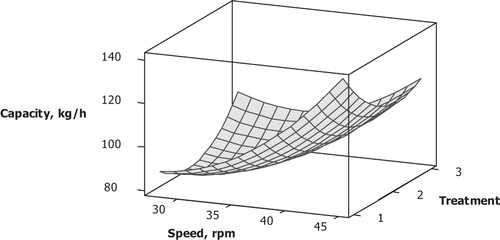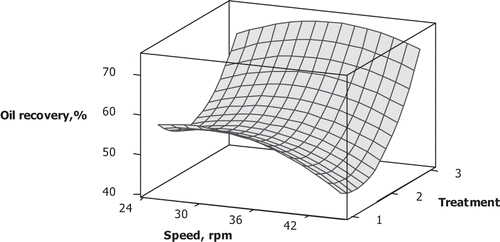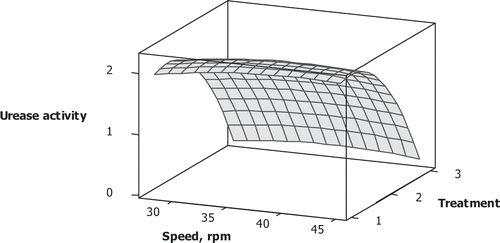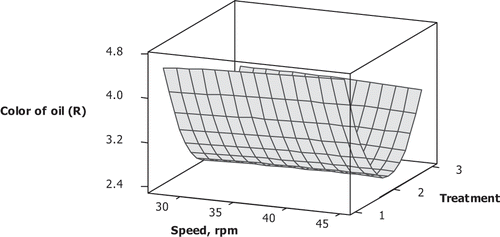Abstract
The effect of expeller screw press and pre-treatments on the quality and quantity of soybean oil and cake was studied using a commercial oil expeller. The pretreatments included whole soybean crushing, soy grits crushing, and crushing of soy grits extruded at 135°C. The screw speeds were 28, 35, and 45 rpm. The moisture content of soybean used in the experiment was 10% wet basis. The average capacity of the oil expeller was found to be 145 kg/h, 110 kg/h, and 120 kg/h for whole, grits, and extrudate, respectively at 45 rpm. The average capacity of oil expression from whole soybean did not vary significantly from 28 to 45 rpm. In the case of soy grits, however, the capacity was higher when the expeller speed was lowest, i.e., 28 rpm. In the case of extrudate, even in a single pass, the recovery was higher, i.e., to 71% at both 45 and 35 rpm. The color of oil from soy grits was lighter followed by extrudate, and the color of oil obtained from whole soybean was dark. The FFA in oil from all the samples was below 1%, however the lowest percentage was for oil obtained from extrudate at 0.5%. The urease activity of the extruded cake was 0.15 pH units, and the protein and oil content were about 48% and 5%, respectively. The optimum process variables for mechanical expelling of soybean were found to be extrusion as a pretreatment and speed of expeller screw at 45 rpm, which yielded throughput capacity 103 kg/h, oil recovery of 70.5%, and urease activity of the cake at 0.15.
INTRODUCTION
Soybeans are relatively hard oil seeds containing less than 20% oil, hence it is hard to express the oil from soybean with a mechanical screw press. The solvent extraction process, in which oil is leached from flakes using hexane, is a popular was to remove/extract oil from soybean. The solvent extraction plants are expensive and are not generally suitable for smaller catchments in India. The smallest capacity oil extraction plant based on hexane, which can be economically feasible, comes in 100 tons/day capacity. That means on the basis of average soybean productivity in India, the produce from at least 100 ha land will be required to run the solvent based plant each day; thus for 300 days operation, about 30,000 ha catchment area under soybean will be required. On the other hand, a mechanical screw press costing only about US $1000–3000 are available commercially and operate efficiently for soft seeds. In India there are number of such oil presses in use by the small oil millers. The millers have tried to crush soybean in these machines but were only able to attain very low oil yields. The mechanical pressing soybean for oil also required pressing in several passes, which caused overheating of the meal, resulting in a brown color and scorched flavor.[Citation1] The mechanical pressure produced darkening and deteriorated the quality of the oil, which cannot be used for food purposes.
In India, conventional mechanical expellers used for soybean, along with efficient pre-milling treatment, will make operations more economical. This will also reduce the use of hexane, which otherwise is considered in safe due to its carcinogenic effects. Rather than attempting to gain the maximum oil expressed by an expeller, consideration should be given to the quality of cake that will yield edible quality flour. A single pass operation should be able to generate edible quality, chemical free oil, as well as edible quality medium fat soy flour, economically at a small industry level. According to research at INTSOY[Citation1] and also at CIAE,[Citation2] the soy treated with dry extrusion before expelling produced good quality oil and medium fat soy flour. It has also been reported that pre cooking of soy grits also helped improve the oil recovery by mechanical press.[Citation2] Crowe et al.,[Citation3] reported that the extrusion expelling process was suitable for soybean with various characteristics (moisture, whole, or dehulled), but the residual moisture content in the cake was found to be higher in the cake obtained from dehulled soybean. The quality of extrusion expelled oil was reported by Wang and Johnson.[Citation4] They reported that extrusion expelled oil had greater peroxide values and lesser free fatty acids and phosphorous than solvent extracted and continuous screw press oils. The quality of cake/flour was reported by Heywood et al.,[Citation5] in terms of its functionality. The functionality of soy flour was found to reduce with reduction in its residual oil content. All these reports indicate that extrusion expelling can be effectively used on commercial scale. However, when we visited and surveyed the small scale oil expelling plants, we found that they operate at different operating conditions. The feed moisture content, as well as speed of the screw press, varied considerably from mill to mill, and hence, a recommendation is needed on using the commercial screw presses for expressing the soybean oil to achieve an economy of operation. The objectives of this article were therefore 1) To study the effect of screw speed and pre-treatments on soybean oil recovery by commercial expellers. 2) To study the effect of process parameters on the quality of cake and oil.
MATERIALS AND METHODS
The soybean of Punjab 1 variety, grown on the CIAE farm, was used in the study. The well dried grains, having a moisture content of 10% wet basis, were cleaned with an air screen grain cleaner (CIAE, Bhopal, India) and were stored in air-tight metallic containers untill the were required for studies. The whole soybean grains were dehulled in a concentric cylinder dehuller (CIAE, Bhopal, India). The separated husk was blown off by the aspirating fan of the dehuller, and whole splits were obtained for further use. The whole soybean, as well as soy splits, were converted into grits by a fixed hammer mill having the serrated impacting surface and wire mesh at the bottom to get the desired grit size (CIAE, Bhopal, India). The pretreatment of high temperature short time cooking to the grits was given by a single screw dry extruder (Model Insta Pro Jr. 600, Triple F Inc, Des Moines, Iowa, USA). The extruder was operated at stable conditions of 135°C die temperature and extruder screw speed of 550 rpm and throughput capacity of 250 kg/h. The expelling of oil from soybean after subjecting to various pretreatments was done with a commercial oil expeller (Model Young 9 bolt oil expeller, SP Engineering Co., Kanpur) at three different expeller screw speeds. The observations were taken when the expeller achieved the stabilized condition of throughput, oil and cake recovery.
The experimental plan followed was as given in . There were two factors namely, the speed of the screw press and the degree of pretreatment. Three levels of screw speed were achieved by using three sizes of main shaft pulleys on the expeller, whereas three levels of degree of pretreatment were: Level 1, no treatment that means whole untreated soybeans were used, Level 2, soybeans were milled into grits, and Level 3 was where soybeans were milled in the form of grits and were further extruded at 135°C by a single screw dry extruder. The screw configuration for soybean was attered very little than was suggested for soft seeds by the manufacturer of the expeller. The configuration was decided based on many trial runs; it was similar to soft seeds, except that the reverse flight near to the choke had a 25° flight angle instead of the 15° used for soft seeds, and the choke end portion was elongated with 13 mm extra spacer. The extrusion of the grits was performed at natural moisture content of 10% wet basis, but the initial expeller warm up was done at 13% moisture content.
Table 1 Experimental plan for oil expression studies on soybean.
The moisture content of each sample was measured by oven drying,[Citation6] crude protein content (N × 6.25) was determined by Kjeldahl's method[Citation6] and fat content was determined by the Soxhlet method.[Citation6] The color of the oil was measured by Lovibond Tintometer (Model AF 900, The Tintometer Ltd., Salisbury, United Kingdom).[Citation7] The experiments were conducted in duplicate and data obtained from composite samples from each test were used for statistical analysis. The response surface analysis, as well as response optimization, was conducted using Minitab 14 software (Minitab Inc., State College, PA).
RESULTS AND DISCUSSION
Operational Characteristics of Oil Expeller
The operating characteristics of commercial oil expeller, such as its power requirement, throughput capacity, and oil recovery as effect of screw speed and pretreatment to soybean were determined. It was found that during expelling, the power required varied with the moisture content of the feed as well as pre treatment of size reduction (). The power at no load for expeller was only 3.8 kW compared to 10 kW required by the dry extruder. The power required was 4.2 kW for grits compared to 5.7 kW for whole beans at 13% moisture, whereas at 10% moisture, the power requirement was 6 and 4.5 kW for whole beans and grits, respectively.
Table 2 Power required by commercial oil expeller.
The average capacity of the oil expeller was found to be 145 kg/h, 110 kg/h, and 120 kg/h for whole, grits, and extrudate, respectively at 45 rpm. The detailed data on throughput variation at different speeds was as given in . Generally the expeller in the conventional oil expelling industries operates at very low speed, i.e., about 25–30 rpm. Hence, these study were important to see the effect of increased speed on the performance of the machine. The throughput capacity of the machine may be reduced when the speed of the expeller is reduced; however, it saves on the size of the motor required, as well as allows sufficient time for material in expeller to get effectively squeezed/expressed.
Table 3 Through put capacity of the oil expeller.
The data on oil recovery as effect of pretreatment as well as speed of the expeller was as given in . The oil recovery of whole soybean and grits was obtained in 2 passes, whereas for extrudate only a single pass was necessary to express a significant quantity of oil. The average capacity for oil expression did not vary significantly in the case of whole soybean between the speed range of 28 to 45 rpm. In the case of soygrits, however, the capacity was higher when the expeller speed was the lowest, i.e., 28 rpm. The oil recovery was 72.4%, 70.3%, and 66.3% in two passes at 28, 35, and 45 rpm, respectively. In case of Extrudate, which also utilized the single pass, the recovery was higher—71% at both 45 and 35 rpm, whereas it dropped down to 68.42% at 28 rpm, which may be due to the fact that longer residence time may allow re-absorption of the oil in the cake. The optimum oil recovery was found to be 71.05%, 67.1 %, and 66.3% in the case of soy extrudate, whole soybean, and soy grits at 45 rpm, respectively. However, it may be noted that extrudate was pressed in single pass, whereas, others were crushed in two passes. Hence the oil recovery from all pre-treatments were also evaluated with only a single pass of crushing.
Table 4 Oil recovery obtained with 9 bolt commercial oil expeller.
Quality of Soybean Oil
The quality of oil is one of the important criteria to make these plants for soybean oil expression. Good quality expellend oil can be sold for edible purposes even only after physical refining. Such physical refining can be done at oil expelling plant. The poorer quality oil needs further chemical refining, and does not offer additional value to expeller owners. The parameters considered for oil quality were free fatty acids (FFA), peroxide value, and color. The oil color from soy grits was lighter, followed by extrudate, and the color from whole soybean was dark. The FFA of oil from all the samples was below 1%, however, in the case of extrudate it was around 0.5% as shown in . The data on color was significantly different between whole soy, soy grits, and extruded, whereas, in the case of FFA, whole soy and soy grits sample were on par and differed significantly from extruded samples. It was found that extrusion pretreatment helped to stabilize the FFA development. The FFA level increased as the degree of pretreatment level decreased. The changes in screw speed did not have any significant effect on this property. The levels of free fatty acids were low and were not objectionable, particularly as they were sixteen or eighteen carbon fatty acids.
Table 5 Quality of oil obtained by mechanical expression.
Peroxide value is another widely used tests for oxidative rancidity of oils. The peroxide value is a measure of the concentration of peroxides and hydroperoxides formed in the initial stages of lipid oxidation. High peroxide values here at extrusion pretreatment, as well as no treatment, may be the result of depletion of peroxides after reaching high concentrations. The peroxide value was found to reduce with increase in screw speed. At lower screw speeds, the peroxide value was lower at level 2 pretreatment, whereas at higher screw speed, the peroxide value was higher with increase in severity of the pretreatment.
Quality of Cake Obtained
Since this process yielded two products, i.e., soy oil and cake, the quality of cake from which medium fat soyflour was obtained was also very important. The quality parameters for cake were protein, fat, and urease activity. The data on quality of cake has been given in . The protein content of the cake was higher at lower speeds especially for whole seeds because in whole seed crushing, the oil recovery was higher at low speeds thus increasing apparent protein content of the cake. At severe pretreatment as that of extrusion cooking, however, the protein content was found to increase with speed. The effect of pretreatment was more predominant at higher speeds than at lower speeds of the screw expeller.
Table 6 Quality of cake obtained by mechanical expression.
It was observed that residual fat content was higher for the cake obtained from crushing of whole seeds at higher screw speed. This was due to the fact that oil expression was low at higher speed due to short residence time. The residual fat was found to decrease with increase in the severity of the pretreatment. It was due to the fact that increase in the degree of pretreatment helped breaking the oil globules effectively and making available oil in the free state for mechanical expression.[Citation2] The urease activity of the extruded cake was 0.15 pH units, which indicated that treatment of extrusion followed by expelling was sufficient to inactivate anti-nutrients. The protein and oil content of cake were about 48% and 5% in extrusion expelled cake and hence it can be used for medium fat soy flour.
Response Surface Analysis and Response Optimization
The response surface methodology (RSM) was used to study the simultaneous effects of screw speed and pre treatments on the performance of the expeller as well as product quality. To carry out response surface modeling, the regression method was performed on experimental results to build mathematical models. The R S optimization function in Minitab 14 statistical package (Minitab Inc, PA) was used to fit the experimental data to polynomial equations. The response surface methodology (RSM) has been used by many researchers to optimize the parameters for product development such as mango soy fortified yogurt,[Citation8] concentrated sweet orange essential oil,[Citation9] finalizing canning protocol for cowpeas,[Citation10] and so on shows the surface plot of throughput capacity as effect of speed of expeller and pretreatment applied. The throughput was found to be affected more by speed than pretreatment. As the severity of pretreatment increased, the throughput increased even at lower speeds. At higher speeds, however, the throughput was not significantly different for all three pretreatments.
The surface graph for oil recovery, as an effect of pretreatment and speed of expeller was as given in . It was found that oil recovery was negatively correlated with the speed of the expeller and positively related to the degree of pretreatment. This showed that oil expression was influenced by pressure applied for crushing and shearing as well as time of holding.[Citation11] The oil expression was followed in more than two passes when it was not possible to express the oil in a single pass. The surface plot shown in was for the total oil recovery with multi passes.
The oil recovery comparison in single pass has been shown in . Similar to the multi pass effect, the oil recovery was higher in a single pass at lower speeds. However, the pretreatment effect showed increase in oil recovery with increase in the degree of pretreatment. In the case of grits, the oil recovery in the single pass was found to reduce, compared to the whole seed crushed in the expeller. This result was similar to the report by Crowe et al.[Citation3] It may be due to the fact that expeller performs the operations of crushing, as well as squeezing. In the case of grits, the mixing of hulls with the finer particles might be causing ineffective squeezing, compared to the whole seed crushing. However, this effect was found to be nullified in the second pass due to the formation of smooth cake in the first pass.
The quality of cake was determined after grinding for its suitability for edible purposes. The criteria for this was the urease activity present in the cake. The presence of urease activity level also indicated the severity of the process. In the case of extrusion combined with expelling, the friction and shear of the material caused a rise in temperature, which helped reduce the urease activity. The surface plot of the change in the urease activity as effect of pretreatment and the expeller speed was as given in . The urease activity was found to decrease significantly with the severity of pretreatment, whereas the change in expeller speed did not have any effect.
The color of the oil, as an effect of pretreatment and screw speed, was as shown in . It was seen that the screw speed did not have any effect on this parameter, whereas the pretreatment were highly responsible for the color. It was observed, that the color of oil obtained from the whole seed crushing was darker due to multi passes and the severity of crushing treatment required to express the oil. It developed the heat, and the temperature rose in the expeller; this caused the discoloration of oil, too. Similarly in the case of extrusion pretreatment, the material had undergone heat treatment during extrusion and also during expelling, hence the color change in the oil was significant. However the color of the oil obtained from the middle level pretreatment of grits was lighter compared to level 1 and level 3 pre treatments.
By taking into consideration the oil expression efficiency, the quality of oil, and quality of cake, the response optimization analysis was conducted to determine the most optimum operating conditions for expelling soybean oil using the commercial oil expeller. For response analysis purposes, the data on capacity, oil recovery, and urease activity were only considered. The target values of capacity, oil recovery, and urease activity were 140 kg/h, 70%, 0.15, respectively. The optimum conditions for getting maximum oil expression and better quality of natural soybean oil were the screw speed at 45 rpm and the pretreatment level at 3, which was extrusion pretreatment. The optimized dependent variables at this condition were estimated as capacity 103 kg/h, oil recovery of 70.5%, and urease activity of 0.15.
CONCLUSIONS
The experiments were conducted to see the effects of pretreatments and screw speed on oil expression by commercial screw presses. The throughput capacity of the expeller was found to be affected more by speed than pretreatment. As the severity of pretreatment increased, the throughput increased even at lower speeds. At higher speeds, however, the throughput was not significantly different for all three pretreatments. It was found that oil recovery was negatively correlated with the speed of the expeller and positively related to the degree of pretreatment. The urease activity was found to decrease significantly with the severity of pretreatment, whereas change in speed of expelling did not have any effect. It was seen that the screw speed did not have any effect on the color, whereas the pretreatment steps were highly responsible for change in color of oil. The optimum conditions for getting maximum oil expression and better quality of natural soybean oil by commercial oil expeller were the screw speed at 45 rpm, and the extrusion as a pretreatment. The optimized dependent variables at this condition were estimated as capacity 103 kg/h, oil recovery of 70.5%, and urease activity of 0.15.
REFERENCES
- Nelson , A.l. , Wijeratne , W.B. , Yeh , S.W. , Wei , T.M. and Wei , L.S. 1987 . Dry extrusion an as aid to mechanical expelling of oil from soybeans . J. Am. Oil Chem. Soc. , 64 ( 9 ) : 1341 – 1347 . [CSA]
- Nawab , A. 1992 . Final report of the Indo US sub project on Soybean Processing and Utilization , Bhopal, , India : CIAE .
- Crowe , T.W. , Johnson , L.A. and Wang , T. 2001 . Characterization of extruded-expelled soybean meals and edible flours . J. Am. Oil Chem. Soc. , 78 : 775 – 779 . [CSA]
- Wang , T. and Johnson , L.A. 2001 . Survey of soybean oil and meal qualities produced by different processes . J. Am. Oil Chem. Soc. , 78 : 311 – 318 . [CSA]
- Heywood , A.A. , Myers , D.J. , Bailey , T.B. and Johnson , L.A. 2002 . Functional properties of low fat soy flour produced by an extrusion-expelling system . J. Am. Oil Chem. Soc. , 79 ( 13 ) : 1249 – 1253 . [CSA]
- Association of Official Analytical Chemists (AOAC) . 1980 . Official methods of analysis of the Association of Official Analytical Chemists , 13th , 817 817 Washington, DC : AOAC .
- American Oil Chemical Society (AOCS) . 1987 . Official methods and recommended practices of the American Oil Chemical Society , 4th , Champaign, IL : AOCS .
- Pradyuman , K. and Mishra , H.N. 2003 . Optimization of mango soy fortified yogurt formulation using response surface methodology . Int. J. of Food Properties , 6 ( 3 ) : 499 – 517 . [CSA] [CROSSREF]
- Zeboudj , S. 2005 . Belhanèche-Bensemra, N.; Belabbès, R. Use of surface response methodology for the optimization of the concentration of the sweet orange essential oil of Algeria by wiped film evaporator . J. of Food Eng. , 67 ( 4 ) : 507 – 512 . [CSA] [CROSSREF]
- Afoakwa , E.O. , Samuel , E.Y. and Sakyi-Dawson , E. 2006 . Response surface methodology for optimizing the pre-processing conditions during canning of a newly developed and promising cowpea (Vigna unguiculata) variety . J. of Food Eng. , 73 ( 4 ) : 346 – 357 . [CSA] [CROSSREF]
- Sukumaran , C.R. and Singh , B. 1989 . Compression of a bed of rapeseeds-the oil-point . J. of Agricultural Engineering Research , 42 : 77 – 84 . [CSA] [CROSSREF]




